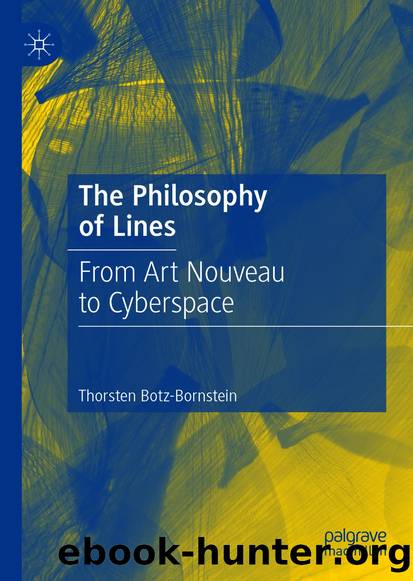The Philosophy of Lines by Thorsten Botz-Bornstein

Author:Thorsten Botz-Bornstein
Language: eng
Format: epub
ISBN: 9783030653439
Publisher: Springer International Publishing
The Line as Cognition: Fichte
But let us first move back a century, and see what the situation was like just before non-Euclidean geometry emerged, that is, before Gauss, Bolyai, and Lobachevsky. Through Euclid, space had become abstract and homogenous, and thus all-penetrating. Philosophers of the late eighteenth century would expand this model by rethinking the connection between being and geometry. Compared to Descartes, the focus was now more on cognition. The idealist German philosopher Johan Gottlieb Fichte attempted to explain all human action in terms of geometry and found that even human thinking could only be conceived of as taking place in space. This idea would much later have some impact on Bergson. In his New Exposition of the Science of Knowledge (Darstellung der Wissenschaftslehre aus dem Jahre 1801), Fichte depicts action as a point, and the whole as a point extended to infinity. The single point is âa point in absolute emptiness, wherein it grasps and penetrates itself,â and the whole is âa point extended to infinite separability, and yet remaining a point.â More precisely, the point for Fichte is a âliving and self-luminous form of line-drawing. In a line, the point is everywhere, for the line has no breadth. In a line, manifoldness is everywhere for no part of the line can be regarded as a point, but only as a line in itself, as an infinite separability of points.â2
A year earlier, Fichte had rather lengthily explained, in his The Vocation of Man, why the line model should be converted into a general model of cognition. It is a kind of Euclidean cognitive science. The following conversation between the author and a âspiritâ (Geist) is supposed to make this clear:
Spirit: But what shape then is assumed, not by thy produced, but by thy inherited, knowledge, of which all specific thought is but the revival and farther definition?âHow does this present itself to thee? Under what image does it appear?
I: Evidently as something in which one may draw lines and make points in all directions, namely, as space.3
Download
This site does not store any files on its server. We only index and link to content provided by other sites. Please contact the content providers to delete copyright contents if any and email us, we'll remove relevant links or contents immediately.
The remains of the day by Kazuo Ishiguro(8790)
Tools of Titans by Timothy Ferriss(8186)
Giovanni's Room by James Baldwin(7164)
The Black Swan by Nassim Nicholas Taleb(6989)
Inner Engineering: A Yogi's Guide to Joy by Sadhguru(6705)
The Way of Zen by Alan W. Watts(6482)
Asking the Right Questions: A Guide to Critical Thinking by M. Neil Browne & Stuart M. Keeley(5601)
The Power of Now: A Guide to Spiritual Enlightenment by Eckhart Tolle(5584)
The Six Wives Of Henry VIII (WOMEN IN HISTORY) by Fraser Antonia(5380)
Astrophysics for People in a Hurry by Neil DeGrasse Tyson(5122)
Housekeeping by Marilynne Robinson(4306)
12 Rules for Life by Jordan B. Peterson(4237)
Double Down (Diary of a Wimpy Kid Book 11) by Jeff Kinney(4182)
The Ethical Slut by Janet W. Hardy(4163)
Skin in the Game by Nassim Nicholas Taleb(4144)
Ikigai by Héctor García & Francesc Miralles(4102)
The Art of Happiness by The Dalai Lama(4051)
Skin in the Game: Hidden Asymmetries in Daily Life by Nassim Nicholas Taleb(3907)
Walking by Henry David Thoreau(3878)
